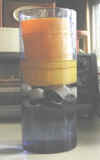| 12-5-05
Outside the temperature was well below freezing and clouds that hinted
strongly of snow scudded in from the west. A great day to fix some fresh
shaggymane mushrooms, I thought, as the door of the frig swung open.
Fresh shaggymanes? You ask: “Where you gonna gettum?”
Actually, the shags I wanted to cook were not all that fresh. Matter
of fact, they were more than three weeks old. Anyone who has had hands-on
experience with shaggymanes knows that these delightful fungi go over the
hill pretty fast once the elongated caps break away from the stems and
start to flatten out like parasols (toadstools, if you prefer).
No, they weren’t fresh in the sense that they had just been picked.
But they weren’t frozen, nor were they dried. They had been in my frig
for more than three weeks because I had picked them a few days before the
firearms deer season had opened (November 12). That season had ended November
27 and here it was December 3, a good three weeks after I had picked the
shags.
So although the shags could not be considered “fresh,” they were totally
free of the black color that is so characteristic of shags that have gone
over the hill. And though they weren’t as crisp as shags just picked, they
were solid to the touch.
So how could these shags be fresh and as tasty as if they had been picked
that very day?
My recipe (procedure) for frying shaggymanes has been featured in his
column with some regularity over the years (about as regularly as shaggymanes
appear), so we will suffice it to say they were delightful when parlayed
with some smallish steaks fried in the same skillet.
As I see it, this column is about preserving shaggymanes, not necessarily
cooking them.
In this column, I have noted, from time to time, that my experiments
establish the notion (if not scientific fact) that the caps of shags turn
black at their outer (lower) perimeter soon after they break away from
the stem. It also seemed that exposure to air causes this change, and that
it transforms shag caps into globs of an inky-black paste sitting on top
of a stem.
Thus, for several years, when “cleaning” shags, I have removed the outer
(lower) perimeter of the caps with the idea that if this portion is not
there, it will turn black somewhere else, and that the remainder of the
cap will remain white and fresh if it can be kept free of air.
This has worked. I have been successful in keeping shags white (free
of the black color) for as long as three months by keeping them totally
immersed in water and refrigerated. However, shags kept for lengthy periods--say
more than a month--tend to be softened (even mushy) by the water.
The problem with keeping shags in good shape seemed to stem from the
fact that no matter what kind of receptacle I used, some air always seemed
to creep in and blacken the shags.
Thus, when cleaning this bag of shags (I was pretty sure it would be
the last of the year, and I wanted to save them as long as I could), I
looked for a narrow, cylindrical receptacle. That turned out to be a clear-plastic
vase, roughly three inches in diameter and a foot tall.
With the cleaned shags in the vase, I covered them with cold tap water.
The shags came to the surface of the water, but a deep, yellow plastic
cup slightly smaller in diameter (with a little water for ballast as a
“sort-of” plunger) pushed the shags below the waterline and kept them there.
And they were “fresh” three weeks later.
Click
on thumbnail image for enlarged view.
| With the cylindrical vase partially filled
with cold water, the yellow plastic cup (partially filled with water) keeps
wine-bottle corks well below the surface of the water in the vase. Wine-bottle
corks are far more bouyant than shaggymane mushrooms. |

|
|

